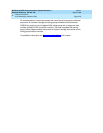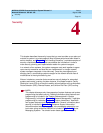
MERLIN LEGEND Communications System Release 6.1
Network Reference
555-661-150
Issue 1
August 1998
Security
Page 4-7Facility Restriction Levels and Remote Access
4
The system manager sets the options listed below for the remote access default
COR on his or her own system. If the system is linked to the network by tandem
tie facilities (analog, T1-emulated voice, or data), the settings are assigned to all
tie trunks. If only tandem PRI trunks link the system to the network, the settings
are assigned to all non-tie trunks. If both tandem tie and tandem PRI trunks are
connected to a system, the default COR FRLs and other restrictions are assigned
to their restrictive types of trunks.
■ Barrier Code Requirement. In a network, this setting should be turned on
in order to require barrier code entry on calls that arrive from the PSTN
over DID or PRI dial-plan routed facilities or that are made by dialing a
Remote Access code included in the non-local dial plan. When barrier
codes are not required, the remaining default COR settings apply to PSTN
calls as well as network calls. This poses a security risk and does not allow
adequate protection against toll fraud. The barrier code requirement is
ignored for calls on tandem trunks, but the remaining default COR setting
does apply to such calls.
When barrier codes are required, the following restrictions can be assigned
to individual barrier codes used on remote access calls that arrive on PSTN
lines/trunks or that are made by dialing a Remote Access code included in
the non-local dial plan:
— Restriction. Determines whether remote access users can make local
and/or toll calls, and includes the following settings: Unrestricted, Toll-
restricted, and Outward-restricted.
— ARS FRL. Allows or restricts use of outgoing trunks by assigning an
FRL. The FRL ranges from 0 (most restrictive) to 6 (least restrictive).
— Allowed/Disallowed Lists Assignment. Disallowed Lists can be
assigned. The factory setting is 3. Do not assign any Allowed Lists.
■ Calling Restrictions. This setting determines whether local and/or toll
calls are allowed. The factory setting is outward- and toll-restricted. To
allow call routing to the PSTN or to another system in the network, this
setting should be changed to unrestricted, allowing the routing of all such
calls.
■ Facility Restriction Level. Use this FRL setting by assigning a restriction
level from 0 to 6, 0 is the most restrictive, and 6 is the least restrictive. The
FRL value assigned here is the opposite of the FRL value assigned to an
ARS route, where a value of 0 is the least restrictive, and a value of 6 is the
most restrictive. The factory setting is 3. To restrict calls from using
selected UDP or ARS routes, assign a value that is lower than the FRL
assigned to the route. Network call routes (UDP or ARS) use this default
COR FRL and do not use barrier codes. As long as you require barrier
codes for the default COR setting, the barrier code FRL and not the default
COR FRL, is applied to remote access calls that arrive on PSTN dial-plan
routed PRI facilities or on DID trunks or that are made by dialing a Remote
Access code included in the non-local dial plan.
■ Allowed List Assignment. Do not assign any Allowed Lists.


















